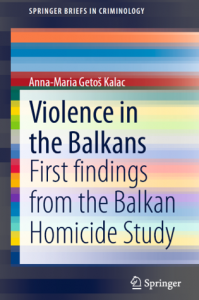In 2016, the Max Planck Partner Group for Balkan Criminology started a new empirical study on homicide in eight South-Eastern European countries: Albania, Bosnia and Herzegovina, Croatia, Kosovo, Macedonia, Romania, Serbia and Turkey. Under the MPPG’s first research focus on “Violence, Organized Crime and Illegal Markets” the study of violence in the Balkans will not only provide an empirically based insight into the phenomenology and aetiology of violence; it will also be a further cornerstone within the research concept of an in depth ‘mapping’ of the criminological landscape of the Balkans. After having mapped the criminological and penological landscape of the region, mapping violence in the Balkans represents the next step on the MPPG research agenda and follows two complementary lines of inquiry.
The first project is based on a more general approach to violence as apparent in the Balkans; it includes violent acts understood as a rather broadly defined phenomenon which depends on country specific circumstances. The project provides a complete geographical coverage of the region, including all BCNet partner countries. Its approach is two-fold: it aims to simultaneously capture violence as both a legal construction and as a criminological reality. The results will provide country specific and regional results about violence, including the legal framework, especially sentencing rules and practices, phenomenology of violence, different types of violence, country specific violence discourses, violent crime rates and trends, aetiology of violence, offender and victim characteristics, etc.
Parallel to the ‘general mapping’ of violent crime, the MPPG is also pursuing a second line of inquiry based on a more focused approach in terms of subject and country coverage: the “Balkan Homicide Study”. The new study will not ‘only’ provide an insight into the social and legal construction, as well as the phenomenology of homicide in the Balkans. The topic also links to the typical ‘Balkan images’ or stereotypes, with the most prominent ones portraying the ‘Balkan people’ as ‘clan people’ prone to wild, violent and revengeful behaviour, which is set up in a culture of drinking slivovitz and running around with guns and shooting at each other for no good reason. This image also lies at the very core of the negative connotations of the term Balkans. Its empirical illumination is also one of the main goals of the study, since existing data already indicates that non-conflict deaths in the Balkans are indeed decreasing and currently around the “European average”, perhaps even beneath it. Interestingly, this does not seem to affect the Balkan stereotype as being a region prone to violence. This regional research project will collect and analyse original empirical data on the most severe type of violence, homicides, in the eight above mentioned countries of the region. The study analyses finalised as well as attempted homicide offences through the thorough examination of the full national samples of prosecution and court cases for the three year period 2012 – 2014, with an exception of Turkey where random sample of 400 cases for the three year period has been selected. The research project attempts to answer questions on phenomenology of homicides, characteristics of victims and offenders, their relationships, situational circumstances, possible connections of the offences with illegal markets and organised crime, criminal procedure issues, etc. The project is designed as a pilot study which in the long run should be realised in all the BCNet partner countries.
This newly published book, “Violence in the Balkans: First findings from the Balkan Homicide Study", written by the head of Balkan Criminology Assoc. Prof. Dr. Anna-Maria Getoš Kalac, offers a first in-depth look at (lethal) violence in the Balkans. Based on the data collected through the Balkan Homicide Study, it presents results from analysis of 3,000 (attempted) homicide cases from Croatia, Hungary, Kosovo, Macedonia, Romania and Slovenia. Shedding light on a region long neglected in terms of empirical violence research, this volume offers answers to (until now) unanswered questions: Amongst other questions and considerations, the brief discusses regional commonalities throughout the Balkans in view of their cultural, historical and normative context. Dismantling negative stereotypes of a growing and thriving Balkan society, this volume will be of interest to researchers in the Balkans, researchers of post-conflict regions, and those interested in the nature of homicide and its motivation, prevention, and various criminal justice approaches. For anyone interested in the violence typology created through the data collected in the Balkan Homicide Study, complementary methodological material is available on the website; BHS: Violence Typology, BHS Codebook.
Mapping Violence in the Balkans
Balkan Homicide Study
First findings from the Balkan Homicide Study

